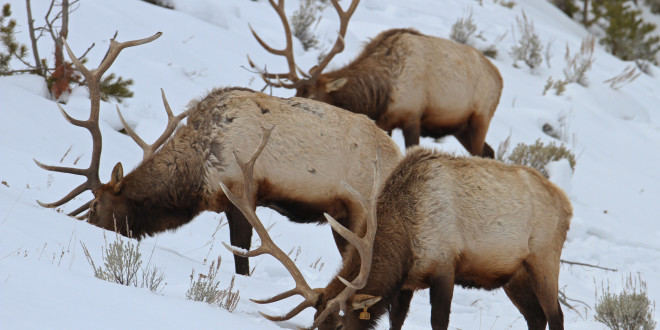The elk population in northern Yellowstone National Park/southern Montana is stable according to a new survey released this week.
Conducted by the Northern Yellowstone Cooperative Wildlife Working Group, the survey counted 4,912 elk in the region. That’s up from last winter’s count of 4,844 elk. All told, 3,758 elk were seen north of the Park’s boundaries, with the remaining 1,154 seen within Yellowstone. According to the Bozeman Daily Chronicle, this count is pretty standard when considered alongside counts from years past:
In a way it’s good news,” said Doug Smith, a Yellowstone National Park biologist. “We think we have a fairly stable elk herd.”
In the mid-1990s, the northern Yellowstone herd had been counted at about 19,000 elk. The highest count in recent years was in 2010, when biologists saw just more than 6,000.
The biologists didn’t count each individual elk in the region, and Smith said the number they ended up with represents a minimum. But, he said the results line up with similar counts conducted since about 2010, and indicate the population has not severely fluctuated up or down.
The count, which was done by airplane, happens every year. It documented sightings of individual elk and didn’t classify them by sex or age.
“The idea is to cover the whole range and count every single elk,” said Karen Loveless, a biologist with Montana Fish, Wildlife and Parks.
Loveless quickly adds, however, that the elk herd around northern Yellowstone may not be permanently stable. Indeed, last November, hunting in a portion of Hunting District 313 was closed prematurely. In addition, FWP officials recently proposed limiting the hunt in HD 313 to 75 elk, out of concern that the ratio between mature bulls and cows was skewing negatively in disfavor of stability. According to the Chronicle, 313 would sometimes average 1,500 hunted elk a year. And even though the survey declared the elk population “stable,” this assessment is, for the most part, generalized. From the Chronicle:
Because this count didn’t classify the animals by age or sex, it didn’t weigh in on that debate. But, Loveless flew over the region for a separate survey in late December and kept track of the bulls she saw in that hunting district.
She saw 116 brow-tine bulls, which are bulls older than about 2 years. Of those, she said about 44 percent were six-point or better, and about 56 percent were five-point or smaller.
She said she wasn’t sure how many elk they missed in that count, but that what she saw “corroborates what we’ve been saying all along.”
The past few years have been a bit tumultuous for Yellowstone elk. The reintroduction of wolves, along with a surge in Yellowstone’s bison population, has undoubtedly affected the movement and behavior of elk, with more migrating north in winter.
A final ruling on hunting in HD 313 is expected by February.
 Yellowstone Insider Your Complete Guide to America's First National Park
Yellowstone Insider Your Complete Guide to America's First National Park





